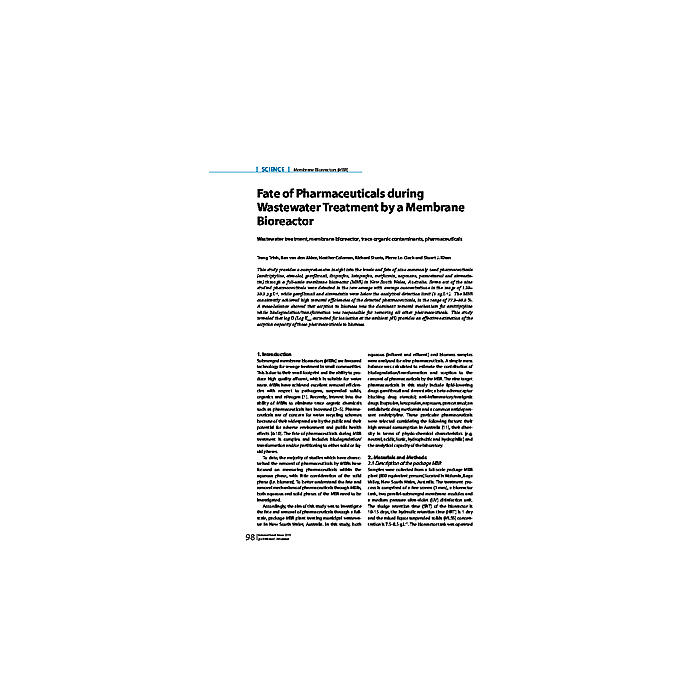Fate of Pharmaceuticals during Wastewater Treatment by a Membrane Bioreactor
4,90 €
Auf Lager
Artikelnummer
05399_2011_SP1_09
This study provides a comprehensive insight into the levels and fate of nine commonly used pharmaceuticals (amitriptyline, atenolol, gemfibrozil, ibuprofen, ketoprofen, metformin, naproxen, paracetamol and simvastatin) through a full-scale membrane bioreactor (MBR) in New South Wales, Australia. Seven out of the nine studied pharmaceuticals were detected in the raw sewage with average concentrations in the range of 1.29-33.3 µg.L-1, while gemfibrozil and simvastatin were below the analytical detection limit (1 ng.L-1). The MBR consistently achieved high removal efficiencies of the detected pharmaceuticals, in the range of 77.2-99.9 %. A mass-balance showed that sorption to biomass was the dominant removal mechanism for amitriptyline while biodegradation/transformation was responsible for removing all other pharmaceuticals. This study revealed that log D (Log Kow corrected for ionisation at the ambient pH) provides an effective estimation of the sorption capacity of these pharmaceuticals to biomass.
| Autoren | Trang Trinh/Ben van den Akker, Heather Coleman, Richard Stuetz, Pierre Le-Clech and Stuart J. Khan |
|---|---|
| Erscheinungsdatum | 30.06.2011 |
| Format | |
| Zeitschrift | gwf - Wasser|Abwasser - Special 1 2011 |
| Verlag | DIV Deutscher Industrieverlag GmbH |
| Sprache | English |
| Seitenzahl | 5 |
| Titel | Fate of Pharmaceuticals during Wastewater Treatment by a Membrane Bioreactor |
| Beschreibung | This study provides a comprehensive insight into the levels and fate of nine commonly used pharmaceuticals (amitriptyline, atenolol, gemfibrozil, ibuprofen, ketoprofen, metformin, naproxen, paracetamol and simvastatin) through a full-scale membrane bioreactor (MBR) in New South Wales, Australia. Seven out of the nine studied pharmaceuticals were detected in the raw sewage with average concentrations in the range of 1.29-33.3 µg.L-1, while gemfibrozil and simvastatin were below the analytical detection limit (1 ng.L-1). The MBR consistently achieved high removal efficiencies of the detected pharmaceuticals, in the range of 77.2-99.9 %. A mass-balance showed that sorption to biomass was the dominant removal mechanism for amitriptyline while biodegradation/transformation was responsible for removing all other pharmaceuticals. This study revealed that log D (Log Kow corrected for ionisation at the ambient pH) provides an effective estimation of the sorption capacity of these pharmaceuticals to biomass. |
Eigene Bewertung schreiben


